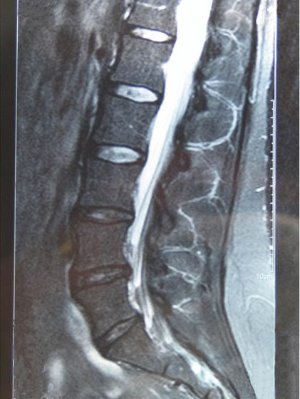Sep. 5, 2008 Research Highlight Biology
Getting to the bottom of lower-back pain
Genetic analysis reveals a biochemical pathway involved in the pathology of a painful spinal disorder
 Figure 1: A magnetic resonance image (MRI) of herniated discs in the lower back.
Figure 1: A magnetic resonance image (MRI) of herniated discs in the lower back.
Lumbar-disc herniation (LDH), in which the cushioning discs that separate and protect the vertebrae of the lower back become deformed or ruptured (Fig. 1), can cause profound discomfort in patients. In severe cases, surgery is required to relieve the resulting back and leg pain.
Accumulating evidence suggests a genetic component to LDH, and most candidate genes identified to date have been involved in maintaining the extracellular matrix (ECM)—the protein scaffolding that serves as infrastructure for the connective tissue that composes the spinal discs.
Now, new work from a group led by Shiro Ikegawa of the Center for Genomic Medicine in Yokohama has revealed the involvement of a novel ECM-related biochemical pathway in hereditary LDH1. Previous studies have suggested that THBS1 and THBS2, two genes encoding proteins from a family known as thrombospondins, might be associated with LDH, and Ikegawa’s group began their study by performing genomic analyses on Japanese LDH patients to see if this condition could potentially be linked to mutations in either of these genes.
Their analysis led to the identification of a single-nucleotide sequence variation in the THBS2 gene that showed significant association with LDH. This mutation appears to lead to altered processing of the RNA transcribed from THBS2, producing a variant of the protein that lacks a domain involved in mediating protein–protein interactions.
In this case, the relevant interacting proteins are matrix metalloproteases (MMPs), enzymes that break down the ECM and play a role in tissue remodeling and repair. The mutation identified by Ikegawa’s group was found to impair the interaction of THBS2 with certain MMPs, suggesting that these enzymes—and their regulation by THBS2—may play an important role in LDH.
In a follow-up genetic study, this hypothesis gained support after an additional LDH-associated mutation was discovered in MMP9, a gene encoding one of the MMPs specifically known to interact with THBS2. In fact, these two mutations in combination were found to associate especially strongly with the occurrence of LDH.
These data suggest a novel mode of regulation for MMP9 via THBS2, and Ikegawa believes that the resulting insights into LDH pathology may yield valuable clinical advances in the treatment or prevention of this disorder. “We are now characterizing the binding sites of THBS2 and MMPs and the control mechanism of THBS2 on MMPs,” he says, “which could lead to the development of innovative drugs.”
References
- 1. Hirose, Y., Chiba, K., Karasugi, T., Nakajima, M., Kawaguchi, Y., Mikami, Y., Furuichi, T., Mio, F., Miyake, A., Miyamoto, T. et al. A functional polymorphism in THBS2 that affects alternative splicing and MMP binding is associated with lumbar-disc herniation. The American Journal of Human Genetics 82, 1122–1129 (2008). doi: 10.1016/j.ajhg.2008.03.013
